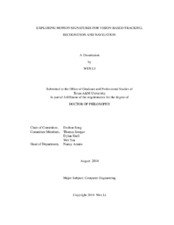| dc.description.abstract | As cameras become more and more popular in intelligent systems, algorithms and systems for understanding video data become more and more important. There is a broad range of applications, including object detection, tracking, scene understanding, and robot navigation. Besides the stationary information, video data contains rich motion information of the environment. Biological visual systems, like human and animal eyes, are very sensitive to the motion information. This inspires active research on vision-based motion analysis in recent years. The main focus of motion analysis has been on low level motion representations of pixels and image regions. However, the motion signatures can benefit a broader range of applications if further in-depth analysis techniques are developed.
In this dissertation, we mainly discuss how to exploit motion signatures to solve problems in two applications: object recognition and robot navigation.
First, we use bird species recognition as the application to explore motion signatures for object recognition. We begin with study of the periodic wingbeat motion of flying birds. To analyze the wing motion of a flying bird, we establish kinematics models for bird wings, and obtain wingbeat periodicity in image frames after the perspective projection. Time series of salient extremities on bird images are extracted, and the wingbeat frequency is acquired for species classification. Physical experiments show that the frequency based recognition method is robust to segmentation errors and measurement lost up to 30%. In addition to the wing motion, the body motion of the bird is also analyzed to extract the flying velocity in 3D space. An interacting multi-model approach is then designed to capture the combined object motion patterns and different environment conditions. The
proposed systems and algorithms are tested in physical experiments, and the results show a false positive rate of around 20% with a low false negative rate close to zero.
Second, we explore motion signatures for vision-based vehicle navigation. We discover that motion vectors (MVs) encoded in Moving Picture Experts Group (MPEG) videos provide rich information of the motion in the environment, which can be used to reconstruct the vehicle ego-motion and the structure of the scene. However, MVs suffer from high noise level. To handle the challenge, an error propagation model for MVs is first proposed. Several steps, including MV merging, plane-at-infinity elimination, and planar region extraction, are designed to further reduce noises. The extracted planes are used as landmarks in an extended Kalman filter (EKF) for simultaneous localization and mapping. Results show that the algorithm performs localization and plane mapping with a relative
trajectory error below 5:1%.
Exploiting the fact that MVs encodes both environment information and moving obstacles, we further propose to track moving objects at the same time of localization and mapping. This enables the two critical navigation functionalities, localization and obstacle avoidance, to be performed in a single framework. MVs are labeled as stationary or moving according to their consistency to geometric constraints. Therefore, the extracted planes are separated into moving objects and the stationary scene. Multiple EKFs are used to track the static scene and the moving objects simultaneously. In physical experiments, we show a detection rate of moving objects at 96:6% and a mean absolute localization error below 3:5 meters. | en |


